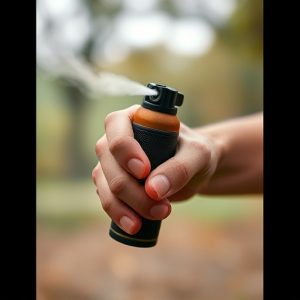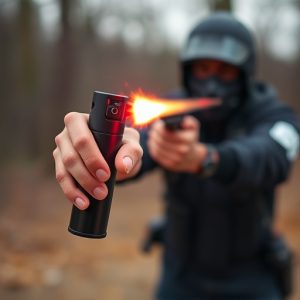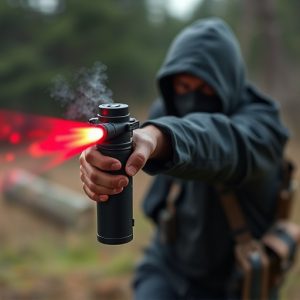Mastering Tactical Pepper Spray: Application & Removal Techniques
Tactical pepper spray offers non-lethal protection in close combat, temporarily disabling aggressors…….
Tactical pepper spray offers non-lethal protection in close combat, temporarily disabling aggressors for escape or help seeking. When selecting a spray, consider range, concentration, and ease of removal, focusing on how easily it can be applied and taken off clothing. Proper application targets sensitive areas like eyes, nose, and mouth, enhancing accuracy and safety. Quick removal techniques involve isolating, using protective gear, carefully taking off contaminated clothes, blotting stains, and soaking with detergent for stubborn marks. Wash affected items separately to prevent cross-contamination.
Tactical pepper spray is a powerful self-defense tool that can provide vital seconds of protection in dangerous situations. This article delves into the world of tactical pepper spray, exploring its purpose, benefits for self-defense, and how to choose the right one for your needs. We’ll guide you through effective application techniques, ensuring maximum impact while prioritizing safety. Additionally, we offer practical steps on removing pepper spray from clothing, a crucial skill for after an encounter.
- Understanding Tactical Pepper Spray: Its Purpose and Benefits for Self-Defense
- Choosing the Right Pepper Spray for Your Needs: Factors to Consider
- Effective Application Techniques: Ensuring Maximum Impact and Safety
- Removing Pepper Spray from Clothing: Practical Steps and Precautions
Understanding Tactical Pepper Spray: Its Purpose and Benefits for Self-Defense
Tactical pepper spray is a powerful self-defense tool designed for situations where immediate protection is needed. Unlike conventional pepper spray, which is often used for general deterrence, tactical spray is formulated to incapacitate an attacker temporarily, giving the user time to escape or seek help. Its primary purpose is to provide a non-lethal response in close-quarters combat, making it a valuable asset for individuals seeking personal safety.
The benefits of tactical pepper spray are numerous. It offers a fast-acting solution, allowing users to disable an aggressor quickly and effectively. This is particularly crucial when facing armed or physically dominant opponents. The spray creates a burning sensation and temporary blindness, disorienting the attacker and providing an opportunity for the user to remove themselves from the dangerous situation. Additionally, tactical pepper spray is easy to use, requiring only a simple trigger pull, making it accessible to people with various levels of physical training. Knowing how to properly apply and remove pepper spray from clothing after use is essential for maximizing its effectiveness as a self-defense mechanism.
Choosing the Right Pepper Spray for Your Needs: Factors to Consider
When choosing a tactical pepper spray for self-protection, consider your specific needs and environment. Factors such as range, power, and carry options are crucial. For instance, if you plan to use it in close quarters like a home or vehicle, a shorter range spray might suffice. However, if you’re venturing into rugged terrain or facing larger threats, opt for a longer-range option with higher concentration levels.
Additionally, think about the ease of removal and accessibility. Pepper spray can be challenging to remove from clothing, so choose a design that allows quick deployment while ensuring it remains secure during use. Features like a one-handed trigger mechanism and a compact, lightweight build can make all the difference in emergency situations, particularly when mobility is key.
Effective Application Techniques: Ensuring Maximum Impact and Safety
When it comes to effective tactical pepper spray application for self-defense, proper technique is key to maximizing its impact while ensuring your safety. The first step is understanding how to target areas most sensitive to the irritant, typically the eyes, nose, and mouth. Aiming directly at these zones can disable an attacker quickly, giving you precious time to escape.
One crucial technique involves creating space between yourself and the opponent before spraying. This allows for a clear line of sight and reduces the risk of accidental self-irritation. Additionally, practicing removing pepper spray from clothing is essential—it’s not just about applying it effectively but also managing its aftermath. With proper training, individuals can learn to use pepper spray as a powerful tool, enhancing their personal safety in potential dangerous situations.
Removing Pepper Spray from Clothing: Practical Steps and Precautions
When dealing with pepper spray, removing it from clothing promptly and safely is crucial for self-protection and comfort. The first step is to quickly isolate yourself and the affected area from any potential re-exposure. Put on protective gloves and cover your eyes and face with a clean cloth or mask. Next, carefully remove the contaminated garments, placing them in a sealed plastic bag for later disposal or decontamination.
To remove pepper spray from clothing, start by gently blotting the stained areas with a damp cloth or cold water. Do not rub, as this can spread the irritant further. For stubborn stains, mix a mild detergent with cool water and gently apply it to the fabric. Soak for several minutes before rinsing thoroughly under cold running water. Always wash affected clothing separately from other laundry to prevent cross-contamination.
Tactical pepper spray is a powerful tool for personal safety, but understanding its proper use extends beyond just carrying it. By learning about different types, considering your specific needs, and mastering application techniques, you can ensure maximum effectiveness in self-defense situations. Additionally, knowing how to remove pepper spray from clothing after an encounter is crucial for practical considerations following an incident. With the right knowledge and precautions, individuals can take control of their safety and be prepared for unexpected challenges.


